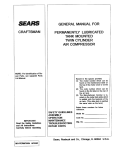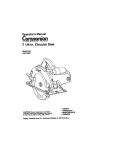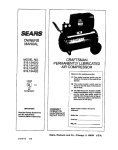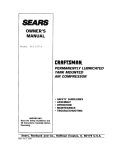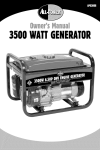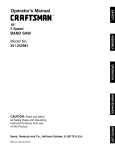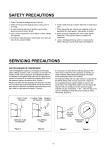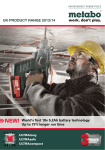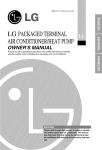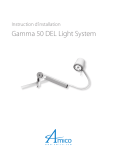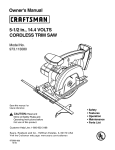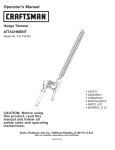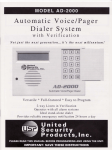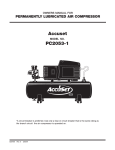Download All-Power APC4016 Operating instructions
Transcript
2.5HP6 GALLON AIRCOMPRESSOR FORTECHNICAL SUPPORTPLEASE AirCompressor Table of Contents Topic Page Safety Guidelines - Definitions 4 Hazard Warnings 5 Air Compressor 15 • Precautions 15 • Basic Air Compressor Components 16 • Assembling the Compressor 16 • Compressor Controls 18 • Electrical Power Requirements 19 • Breaking In The Pump 21 • Operating Instructions 21 • Maintenance 23 • Storage 24 • Service 24 Troubleshooting 25 Glossary of Terms 29 Limited Warranty 3O 2 Owner'sManual WARNING! READ AND UNDERSTAND ALL SAFETY PRECAUTIONSIN THISMANUAL BEFORE OPERATING. FAILURE TO COMPLY WITH INSTRUCTIONS IN THIS MANUAL COULD RESULT IN PERSONAL INJURY, PROPERTY DAMAGE, AND/OR VOIDING OF YOUR WARRANTY.ALL-POWERAMERICA WILL NOT BE LIABLE FOR ANY DAMAGE BECAUSE OF FAILURE TO FOLLOW THESEINSTRUCTIONS. Compressor Inspection Prior to installation and usage, thoroughly for damage or flaws. inspect air compressor • Check tank, compressor, compressor any signs of damage or corrosion. motor and pump for • Check all screws, bolts, nuts and fasteners. are secure. • Confirm that all fittings, tank petcock and hardware are free • of paint, rust and corrosion. Confirm that all compressor set-up and usage. Confirm that they settings are correct prior to Air Tool Inspection Prior to connecting to compressor and usage, thoroughly each air tool for damage or flaws. • Check entire tool assembly corrosion. • Check all assembly for any signs of damage inspect or screws, bolts, nuts and fasteners and confirm that they are secure. • Confirm that all fittings, bits and hardware for integrity. • Confirm that tool settings are correct prior to connection usage. 3 and AirCompressor Safety Guidelines- Definitions This manual contains important informationthat you need to know and understand in order to protect YOUR SAFETY and to PREVENT EQUIPMENT PROBLEMS. The following symbols help you recognize this information. Please read the manual and pay attention to these sections. POSSIBILITY OFPERSONALINJURYORDEATHIF INSTRUCTIONS WARNING!WARNINGSINDICATEA CERTAINTYORSTRONG ARE NOTFOLLOWED. A_ EQUIPMENT DAMAGE IF INSTRUCTIONS ARE NOT CAUTION: CAUTIONS INDICA TE A POSSIBILITY OF FOLL 0 WED. Note: Notes give helpful information. WARNING!IMPROPEROPERATION ORMAINTENANCE OFTHIS PRODUCTCOULDRESULTIN SERIOUSINJURYANDPROPERTY DAMAGE.READANDUNDERSTAND ALLWARNINGS ANDOPERATING INSTRUCTIONS BEFOREUSINGTHISEQUIPMENT.WHENUSINGAIR TOOLS,BASICSAFETYPRECAUTIONS SHOULDALWAYS BE FOLLOWEDTOREDUCETHERISKOFPERSONALINJURY. SaveTheseImportantSafety Instructions! Read and understand all of these safety instructions. Be sure to retain them for future use. 4 Owner'sManual Hazard Warnings Dust WARNING!SOMEDUSTCREATEDBYPOWERSANDING,SAWING, GRINDING, DRILLING,ANDOTHERCONSTRUCTION ACTIVITIES CONTAINSCHEMICALSKNOWNTOTHESTATEOFCALIFORNIATO CAUSECANCER,BIRTHDEFECTSOROTHERREPRODUCTIVE HARM. These chemicals may include (but are not limitedto) the following: • Lead from lead-based paints • Crystalline silica from bricks and cement and other masonry products • Arsenic and chromium from chemically-treated lumber Your risk from these exposures varies, depending on how often you do this type of work. To reduce your exposure to these chemicals: work in a well ventilated area, and work with approved safety equipment, always wear MSHA/NIOSH approved, properly fitting face masks or respirators when using such tools. Always follow basic safety precautions when using air tools to reduce the risk of personal injury. Bursting Rust can weaken the tank. Drain the condensed water from the tank after each use to reduce rusting. If a leak is detected in the tank, replace the tank immediately. Do not weld, drill or modify the air tank of this compressor. Welding or modifications on the air compressor tank can severely impair tank strength and cause an extremely hazardous condition. Welding or modifying the tank in any manner will void the warranty. Check the manufacturer's maximum pressure rating for air tools and accessories. Compressor outlet pressure must be regulated so as to never exceed the maximum pressure rating of the tool. Relieve all pressure through the hose before attaching or removing accessories. Do not adjust the pressure switch or relief valve for any reason. Doing so voids all warranties. They have been preset at the factory for the maximum pressure of this unit. Personal injury and/or property damage may result if the pressure switch or the relief valve are tampered with. Do not use plastic or pvc pipe for compressed air. Use only galvanized steel pipe and fittings for compressed air distribution lines. 5 AirCompressor HazardWarnings(cont'd) Riskof Eyeor HeadInjury What could happen: • Air powered equipment and power tools are capable of propelling materials such as fasteners, metal chips, saw dust, and other debris at high speed, which could resultin seriouseye injury. • Compressed air can be hazardous.The air stream can cause injuryto softtissue areas such as eyes, ears, etc. Particlesor objects propelledby the stream can cause injury. • Tool attachmentscan become loose or break and fly apart propellingparticlesat the operatorand others in the work area. How to prevent it: • Always wear ANSI approvedZ87.1 safety glasses with side shields. • Never leave operatingtool unattended. Disconnectair hose when tool is not in use. • For additionalprotection, use an approved face shield in additionto safety glasses. • Make sure that any attachmentsare securelyassembled. • Never point any nozzle or sprayertoward a person or any part of the body.Equipmentcan cause serious injuryifthe spray penetratesthe skin. 6 Owner'sManual HazardWarnings(cont'd) Riskof Fireor Explosion What could happen: • Abrasive tools such as sanders and grinders, rotating tools such as drills, and impact tools such as nailers, staplers, wrenches, hammers, and reciprocating saws are capable of generating sparks which could result in ignition of flammable materials. • It is normal for the compressor motor and pressure switch to produce sparks while operating. If sparks come into contact with vapors from gasoline or other solvents, they may ignite, causing fire or explosion. • Exceeding the maximum pressure rating of tools or accessories could cause an explosion resulting in serious injury. How to prevent it: • • Never operate tools near flammable substances such as gasoline, cleaning solvents, etc. Work in a clean, well ventilated area free of combustible materials. • Never use oxygen, carbon dioxide or other bottled gases as a power source for air tools. • Use compressed air regulatedto maximum pressure at or below the rated pressure of any attachments. • Never connectto an air source that is capable of exceeding 200 psi. • Always verify priorto using the tool that the air source has been adjusted to the rated air pressure range. • Never spray flammable liquidsin a confinedarea. Do not spray where sparks or flame are present. • Do not smoke while spraying. • Keep compressor as far from spray area as possible. 7 AirCompressor HazardWarnings(cont'd) Riskof HearingLoss What could happen: • Long term exposure to noise produced from the operation of air tools can lead to permanent hearing loss. How to prevent it: Always wear ANSI $3.19 hearing protection when using a compressor. HazardRiSk to Breathing/Inhalation What could happen: • • Abrasive tools such as grinders, sanders, and cut-off tools generate dust and abrasive materials which can be harmful to human lungs and respiratory system. Some materials such as adhesives and tar contain chemicals whose vapors could cause serious injury with prolonged exposure. How to prevent it: • Always wear MSHA/NIOSH approved, properly fitting face mask or respirator when using such tools. Read all instructions and be sure that your respirator mask will protect you. • Always work in a clean, dry, well ventilated area. • Never directly inhale the compressed air produced by a compressor. It is not suitable for breathing purposes. • Be certain to read all labels when you are spraying paints or toxic materials, and follow the safety instructions. 8 Owner'sManual HazardWarnings(cont'd) Riskof Injury What could happen: • Tools left unattended, or with the air hose attached can be activated by unauthorized persons leading to their injury and/or injury to others. • Air tools can propel fasteners or other materials throughout the work area. • A wrench or key that is left attached to a rotating part of the tool increases the risk of personal injury. • Using inflator nozzles for duster applications can cause serious injury. • Air tools can become activated by accident during maintenance or tool changes. • Air tools can cause the work-piece to move upon contact leading to injury. • Loss of control of the tool can lead to injury to self or others. • Poor quality, improper, or damaged tools such as grinding wheels, chisels, sockets, drills, nailers, staplers, etc., can fly apart during operation, propelling,particles throughout the work area causing senous injury. • Fasteners could ricochet or be propelled causing serious injury or property damage. • Improperly maintained tools and accessories can cause serious injury. • There is a riskof burstingif the tool is damaged. • The compressor unitstartsautomatically.Serious injurycould occurfrom contact with moving parts. 9 AirCompressor HazardWarnings(cont'd) Riskof Injury(cont'd) How to prevent it: • Remove air hose when toolis not in use and store tool in secure location away from reach of children and or untrainedusers. • Use only parts, fasteners, and accessoriesrecommendedby the manufacturer. • Keep work area clean and free of clutter. Keep childrenand others away from work area during operationof the tool. • Keep work area well lit. • Remove adjustingkeys and wrenches before turningthe tool on. • DO NOT use inflatornozzles for duster applications. • Remove air hose to lubricateor add grindingattachments,sanding discs, drills,etc. to the tool. • Never carry the tool by the hose. • Avoid unintentionalstarting. • Repair servicingshouldbe done only by an authorizedservice representative. • Use clamps or other devices to prevent movement. • Never operate tool while under the influenceof drugs or alcohol. • Don't overreach. Keep properfooting and balance of all times. • Keep handles dry,clean and free from oil and grease. • Stay alert. Watch what you are doing. Use common sense. Do not operate tool when you are tired. • Always use tool attachmentsrated for the speed of the power tool. • Never use tools which have been dropped, impactedor damaged by use. 10 Owner'sManual HazardWarnings(cont'd) Riskof Injury(cont'd) • Use only impact grade socketson an impact wrench. • Do not apply excessive force to the tool. Let the tool perform the work. • Never pointdischarge of tool at self or others. • Do not pulltrigger unlesstool contact safety device is against work surface. • Never attemptto drive fasteners into hard surfaces such as steel, concrete, or tile when using air tools. • Take care to avoid drivinga fastener on top of another fastener. • Positiontool carefullyso that fasteners will be delivered to the proper location. • Use only accessoriesidentifiedby the manufacturerto be used with specifictools. Maintainthe tool with care. • • Keep a cuttingtool sharp and clean. A properlymaintainedtool, with sharp cuttingedges reducesthe risk of binding and is easier to control. • Check for misalignment of bindingor moving parts,breakage of parts, and any other conditionthat effects the tool'soperation. If damaged, have the tool serviced before using. • Use of an accessory not intendedfor use with the specifictools increasesthe riskof injuryto persons. • Always shut offthe compressor,remove the plug from the outlet, and bleedall pressurefrom the system beforeservicingthe compressor,and when the compressoris not in use. • Do not operate the unit with the shroudremoved. 11 AirCompressor Hazard Warnings (cont'd) Riskof ElectricShock What could happen: • Using air tools to attach electrical electrocution or death. • Improper electrical connections fires,electrocution, or death. wiring can result in can result in This tool is not provided with an insulated gripping surface. Contact with a "live" wire makes exposed metal tool parts "live", resulting in possible electrocution or death. Fasteners coming in contact with hidden electrical wiring could cause electrocution or death. How to prevent it: • Never attach electrical wiring with energized tools. • Avoid body contact with grounded surfaces such as pipes, radiators, ranges, and refrigerators. There is an increased risk of electric shock if your body is grounded. • Thoroughly investigate performing work. • A licensed electrician in accordance must install all wiring. • Never use an electric air compressor outdoors when it is raining or on a wet surface, as it may cause an electric shock. the work piece for possible hidden wiring before with all local and national codes 12 Owner'sManual HazardWarnings(cont'd) Riskof Entanglement What could happen: • Tools containing moving elements or driving other moving tools (grinding wheels, sockets, sanding discs, etc.) can become entangled in hair, clothing, jewelry, and other loose objects, resulting in injury. How to prevent it: Never wear loose fitting clothes, or apparel whichcontains loose straps or ties, etc. which could become entangled in moving parts. Remove any jewelry, watches, identifications, bracelets, necklaces, etc. which might become caught by the tool. Keep hands away from moving parts. Tie up or cover long hair. 13 AirCompressor HazardWarnings(cont'd) Riskof Cut or Burns What could happen: • Tools which cut, shear, drill, staple punch, chisel, etc. are capable of causing serious injury. • The pump and manifold generate high temperatures. How to prevent it: Keep the working part of the tool away from hands and body. • Do not touch the pump, manifold or transfer tube while the pump is running.Allowthem to cool before handling or servicing. • Keep children away from the compressor at all times. 14 Owner'sManual Compressor Item Value Model Number APC4016 Peak H.P. (CV) 3.5 Tank Capacity Gallons/Liters 6 Voltage/Amps/Phase 115/2.6/1 Kick-In Pressure 80 Kick-Out Pressure 100 WARNING! THE POWER CORD ON THIS PRODUCT CONTAINS LEAD, A CHEMICAL, KNOWN TO THE STATE OF CALIFORNIA TO CAUSE CANCERAND BIRTH DEFECTS OR OTHER REPRODUCTIVEHARM. WASH HANDSAFTER HANDLING. Precautions • Drain the moisture from the tank daily to help prevent corrosion. • Pullthe pressurerelief valve ringdaily to ensure proper function and clear possible obstructions. • To provideproperventilationfor cooling,the compressormustbe kept at least 12 inches(31 cm) from the nearest wall, in a well-ventilatedarea. • Fasten the compressorsecurelyand release tank pressure before transporting. • Protectthe air hose and electriccord from damage and puncture. Inspectthem weekly for weak or worn spots, and replace if necessary. • To reduce the riskof electricshock,do not expose to rain. Store indoors. • Never operate the compressorifthe power cord or plug are damaged. Take the equipmentto the nearest Authorized Service Center, and a specialisttechnicianwill replace it. 15 Owner'sManual Compressor(cont'd) BasicAir CompressorComponents The basic componentsof the air compressorare the electricmotor, pump, pressureswitch,and tank. The electric motor(see A) powersthe pump. The electric motoris equippedwith an overload protectorand an automatic reset. If the motorbecomes overheated, the overload protectorwill shut it downto preventdamage to the motor.When the motorsufficientlycools, it will automaticallyrestart. A&B C The pump (see B) compressesthe air and discharges it intothe tank. The tank (see C) stores the compressed air. The pressure switch (located internally)shuts down the motor and relievesair pressure in the pump and transfertube when the air pressurein the tank reaches the kick-out pressure. As compressedair is used and the pressure level in the tank drops to the kick-inpressure, the pressureswitch restartsthe motor automatically,withoutwarning, and the pump resumes compressingair. Assemblingthe Compressor 1 Unpack the air compressor.Inspectthe unitfor damage. If the unit has been damaged in transit, contact the carrier and completea damage claim. Do this immediatelybecause there are time limitationsto damaged claims.The carton should contain: o Air compressor ,o Operator and parts manuals ,_ Handle o Wheel Assembly 16 AirCompressor m Compressor(cont'd) Assemblingthe Compressor(cont'd) Tighten the handle into its position with screws included. 2 Check the compressor's serial labelto ensure that you have received the model ordered, and that it has the required pressure rating for its intended use. 3 Locate the compressor accordingto the following guidelines: a Position the compressor near a grounded electrical outlet (see GROUNDING INSTRUCTIONS, above). b The compressor must be at least 12 inches (31 cm) from any wall or obstruction, in a clean, well-ventilated area, to ensure sufficient air flow and cooling. c In cold climates,store portable compressorsin a heated building when not in use. This will reduce problemswith motorstarting and freezing of water condensation. d Remove the compressorfrom the shippingpalletor cartonand place it on the flooror a hard, level surface.The compressormustbe level to ensure properdrainage of the moisturein the tank. 4 Connect an air hose to the compressorhose outlet. 17 Owner'sManual Compressor(cont'd) CompressorControls • Power switch: This switchturns the compressorpower ON and OFF. • Pressure switch : This switch turnson the compressor. It is operated automaticallywhen the power switch is in the ON position,it allows the compressor to start up or shut down automatically,withoutwarning, depending upon air demand. • Pressure Relieve Valve: If the pressureswitch does not shut down the motorwhen pressure reaches the preset level, this valve will pop open automaticallyto preventover pressurization.To operate manually,pull the ring on the valve to relieve air pressure in the tank. • Tank Pressure Gauge: This gauge measures the pressure level of the air storedin the tank. It is not adjustableby the operator,and does not indicate line pressure. • Air Pressure Regulator : This air pressure regulator enables you to adjustline pressure to the toolyou are using. THETOOL.TURNTHEKNOBCLOCKWISE TOINCREASE PRESSURE, WARMNG!NEVEREXCEEDTHEMAXIMUM WORKINGPRESSURE OF ANDCOUNTERCLOCKWISE TODECREASEPRESSURE. 18 AirCom Compressor(cont'd) CompressorControls(cont'd) • Regulated pressure gauge: This gauge measures the regulated outlet pressure. • Regulated pressure quick connect coupler: This couplerconnects to the regulatedoutlet pressure.To connect air hose, pushcouplerin. To disconnectair hose, pull the couplercollar back and separate the coupling. ElectricalPowerRequirements ElectricalWiring Refer to the air compressor's serial label for the unit'svoltage and amperage requirements. Use a dedicated circuit.For best performanceand reliable starting,the air compressor mustbe plugged into a dedicated circuit,as close as possible to the fuseboxor circuitbreaker.The compressor will use the full capacityof a typical 15 amp householdcircuit.If other devices are on the same circuit, the compressormay fail to start. Low voltage or an overloadedcircuit can result in sluggishstartingthat causes the motoroverload protectionsystem circuitbreaker to trip, especially in cold conditions. connectedto a circuitprotected by a fuse, use dual element time Note: A circuitbreaker is recommended. If the air compressor is delay fuses (Buss Fusetrontype "1" only). is necessary, be sure to use an extension with the correct Note: Avoid use of extension cords. If using an extension cord specifications. For optimum performance, plug the compressor power cord directlyinto a groundedwall socket. Do not use an extension cord unless absolutely necessary. Instead, use a longer air hose to reach the area where the air is needed. If use of an extension cord cannotbe avoided, the cord should be no longer than 100 feet and be a minimum wire size of 14 gauge (AWG). 19 Owner'sManual Compressor(cont'd) ElectricalPowerRequirements (cont'd) ExtensionCord Use the chart on the right for the proper extension cord length. Use only a 3-wire extension cord that has a 3-blade groundingplug, and a 3-slot receptaclethat willaccept the plug of the product. Make sure your extensioncord is in good condition. An undersizedcord will cause a drop in linevoltage as well as a lossof power and overheating. Amp Rating Length of Cord in Feet (120Volts) 25' I 50' 10-12 16 I 14 The smaller the gauge number,the heavierthe cord. 100' t50' 10 8 12-14 16 I 12 10 8 14-16 16 I 12 10 8 16-18 14 I 12 8 8 18-20 14 I 12 8 8 GroundingInstructions This product shouldbe grounded. In the event of an electricalshort circuit, groundingreducesthe risk of electricshock by providingan escape wire for the electriccurrent. This product is equipped with a cord having a grounding wire with an appropriategroundingplug. The plug must be plugged intoan outletthat is properly installedand grounded in accordance with all local codes and ordinance. _k CANRESULTIN A RISKOFELECTRICSHOCK.IF REPA/ROR ARNING!IMPROPER INSTALLATIONOF THEGROUNDING PLUG REPLACEMENT OFTHECORDORPLUGISNECESSARY, DONOT CONNECTTHEGROUNDING WIRETOEITHERFLATBLADETERMINAL. THEWIREINSULATION HAVINGANOUTERSURFACETHATISGREEN WITH,ORWITHOUT,YELLOWSTRIPESIS THEGROUNDING WIRE. This product isfor use on a nominal 110 volt circuit. An outlet with a grounding plug must be used. Make sure that the productis connected to an outlet having the same configurationas the plug. No adapter should be used with this product. Do not alter the plug to fit into a non-grounded or 2-slot receptacle. 2O AirCompressor Compressor (cont'd) Breaking Inthe Pump 1 Turn the pressure switch to the OFF position. 2 Open the petcock. Turn counterclockwise. 3 Plug in the power cord. 4 Turn the power switch to the ON position. The compressor will start. Allow the compressor to run for 15 minutes, to break in the internal parts. CAUTION: AFTER ABOUT 15 MINUTES. IF THE UNIT DOES NOT OPERATE PROPERLY, SHUT DOWN IMMEDIATELY, AND CONTACT PRODUCT SERVICE. 5 After about 15 minutes, turn the power switch to the OFF position. 6 Close the petcock. Turn in the clockwise 7 Turn the power switch to the ON position. The compressor and fill the tank to the kick-out pressure and stop. ® ® direction will start Note: As compressed air is used, the pressure switch will restart the motor automatically. Note: During the initial break-in cycle, there will be a slight electrical smell as the motor brushes seat. This is normal for universal motors and will last for about 5 minutes. WARNING DO NOT START UNIT UNTIL YOU HAVE ADDED OIL. You may use SAEIOW30 synthetic oil such as Mobil 1 which is API CG/CD grade compliant. PUMP OIL LEVEL FILLWINDOW OperatingInstructions Daily Startup 1 Turn the power switch to the OFF position. 2 Close the tank petcock. Turn in the clockwise 3 Plug in the power cord. 21 Q direction. Owner'sManual Compressor(cont'd) OperatingInstructions(cont'd) _ 4 _ ELECTRICAL MOTOR AND THE PUMP. TO PREVENT BURNS OR ARNING! HIGH TEMPERATURESARE GENERATED BY THE OTHER INJURIES, DO NOT TOUCH THE COMPRESSOR WHILE IT IS RUNNING. ALLOW IT TO COOL BEFORE HANDLING OR SERVICING. KEEP CHILDRENAWAY FROM THE COMPRESSOR AT ALL TIMES. Turn the power switch to the ON position. PRESSURE,TURNTHEKNOBCOUNTERCLOCKWISE TOREACHTHE ARNING!WHENADJUSTINGFROMA HIGHERTOA LOWER DESIREDPRESSURE.DONOTEXCEEDOPERATING PRESSUREOF THETOOLORACCESSORY BEINGUSED. 5 Adjust the regulatorto the working pressureof the tool. Shutdown 1 Turn the power switch to the OFF position. 2 Unplug the power cord. 3 Reduce pressure in the tank throughthe outlet hose. You can also pull the reliefvalve ring and keep it open to relieve pressure in the tank. _I! THATMAYCAUSEEYEINJURY.WEARSAFETYGOGGLESWHEN WARNING! ESCAPINGAIRANDMOISTURECANPROPELDEBRIS OPENING PETCOCK. 4 Tip the compressor (if necessaryfor your model) so the petcock is at the bottom of the tank(s). Then open the petcock to allow moisture to drain from the tank. 22 Air Corn Compressor(cont'd) Maintenance _ PLUGTHECOMPRESSOR ANDRELIEVEALLAIRPRESSURE FROMTHE WARNINGITOAVOIDPERSONALINJURY,ALWAYSSHUTOFFAND UNSYSTEMBEFOREPERFORMING ANYSERVICEONTHEAIR COMPRESSOR Regular maintenancewill ensure troublefree operation.Your electric powered air compressorrepresents high quality engineeringand construction;however, even high quality machinery requires periodic maintenance. Inspect the items listedbelow on a regularbasis. Lubrication Thisaircompressor requires regular lubrication forproper operation. /k ® CAUTION: Multi-Viscosity motor oils, like lOW 30, shouldnot be used in an air compressor. They leave carbon deposits on critical components, thus reducing performance and compressor life. Use air compressor oil only. Note: Use air compressor oil such as SAE-20 (API CG/CD heavy duty). Under extreme winter conditions use SAE-10 weight oil. Drain and refill the compressor oil after the first 100 hours of operation. CAUTION: Compressorsare shipped without oil. A small amount of oil may be present in the pump upon receipt of the air compressor. DO NOT ATTEMPT TO OPERATE THIS AIR COMPRESSOR WITHOUT FIRSTADDING OIL TO THE CRANKCASE. Serious damage can result from even limited operation unlessfilled with oil and broken in correctly. Follow initial start-upprocedures closely. WARNING! Drain tank to release air pressure before removing the oil fill cap or oil drainplug. Not doing so could result in serious damage to the compressor as welt as serious injury. Place unit on a level surface. Remove oil fill plug and slowly add compressor oil until it is even with the top of the oil fill hole. (It must not be allowed to be lower than 3/8" from the top at any time.) When filling the crankcase, the oil flows very slowly into the pump. If the oil is added too quickly, it will overflow and appear to be full. Crankcase oil capacity is approximately 16 fluid ounces. Replace oil fill plug. Dram and refill the compressor oil after the first 100 hours of operation. 23 Owner'sManual Compressor(cont'd) Maintenance(cont'd) Draining the Tank Relievetheair pressure inthesystemandopenthepetcock onthebottomofthetankto drain. WARNING! CONDENSATION WILLACCUMULATE IN THE TANK. TO PREVENT CORROSIONOF THE TANKFROM THE INSIDE, THIS MOISTURE MUST BE DRAINED AT THE END OF EVERY WORKDAY.BE SURE TO WEARPROTECTIVE EYEWEAR_ Note: In cold climates, drain the tank after each use to reduce problems with freezing of water condensation. Checkingthe ReliefValve Pull the reliefvalve daily to ensure that it is operating properly and to clear the valve of any possibleobstructions. Testing for Leaks Check that all connections are tight.A small leak in any of the hoses or pipe connections will substantially reduce the performance of your air compressor. If you suspect a leak, spray a small amount of soapy water around the area of the suspected leak with a spray bottle. If bubbles appear, repair or replace the faulty component. Do not overtighten any connections. Storage Before storing the compressor for a prolonged period, use an air blow gun to clean all dust and debris from the STORAGE compressor.Disconnectthe power cord and coil it up. Pullthe pressure reliefvalve to release all pressure from the tank. Drain all moisturefrom the tank. Cover the entire unitto protect it from moisture and dust. Servicing Perform the followingmaintenance at the intervalsindicated below: • Operate the pressure relief valve: Daily • Drain tank: Daily 24 Air Troubleshooting solutions. Note: Troubleshooting problems may have similar causes and Lowpressure,or notenoughair,or compressordoesnotstop • Tank petcock is open ° Close petcock • Prolonged excessive use of air Decrease amountof air used • Compressornot large enough • o Check air requirement of accessory.If it is higherthan CFM and pressure supplied by compressor,you need a larger compressor. Most accessoriesare rated at 25% of actual CFM while running continuously. Restrictedcheck valve • o Remove and clean or replace. Hole in air hose • o Check and replace if necessary. Tank leaks o Replace tank REPAIR WARNING!IMMEDIATELY REPLACETANK.DONOTATTEMPTTO • Blownseals o Replace any faulty seals. o Replace worn parts and reassemblewith new seals. 25 Owner'sManual Troubleshooting(cont'd) Excessivestartingandstopping,whilenot in use • Fittings leak o Check fittings with soapy water. Tightenor reseal leaking fittings.DO NOT OVERTIGHTEN. Replace worn parts and reassemble with new seals. o Replace any faulty seals. • Air leaks from regulator,or regulator does not regulate pressure Dirty or damaged regulator internalparts. o, Replace regulatoror internalparts. • Regulatedpressure gauge readingdrops when air accessory is being used. This is normal in some applications Compressor not large enough o If pressure dropstoo low, adjust regulatorwhile accessory is used. _, Check air requirement of accessory,it may be higher than CFM pressure suppliedby compressor.Most accessoriesare rated at 25% of actual CFM while runningcontinuously. Circuitbreakertrips (fuse blows)too often • Low voltage o Consultelectrician. • Excessivewire length - Furnish adequate power. If usingextension cord, try again without it. • Restrictedair passages o Contact authorizedservice center. • Back pressure in pump head - Replace check valve. o Replace pressureswitch bleeder valve. 26 AirCompressor Troubleshooting(cont'd) Overheating • Poorventilation Relocate compressor to an area with cool, dry and well-circulatedair. • Dirtycoolingsurfaces o Clean all coolingsurfaces of pumpand motorthoroughly. • Leakingvalve Replace worn parts and reassemble with new seals. Motorstalls • Low voltage o Furnish adequate power. • Defective pressure switch bleeder valve Replace pressure switch bleeder valve Pressurereliefvalveopens • Tank pressure exceeded normal operating pressure • Replace pressure switch Pressureswitch stuck o Replace pressure switch Motorwill notrun • Tank pressure exceeds preset pressure switchlimit o Motor will startautomaticallywhen tank pressuredrops below kick-in pressure of pressuretank. • Motor overload protection has tripped o Let motor cool off and overloadswitch willautomaticallyreset. This may take several minutes. 27 Owner'sManual Troubleshooting(cont'd) Motorwill notrun(cont'd) • Fuse blown or circuit breaker tripped o Replace blownfuse or reset circuitbreaker. Do not use fuse or circuit breaker with higherrating than specifiedfor your branch circuit. o Check for properfuse; "Fusetron" type T is acceptable. o Check for low voltage and proper extensioncord size. o Disconnect other applicationsfrom circuit.Operate compressor on a dedicated circuit. • Check valve stuckopen o Remove and clean or replace. • Pressurebleeder valve on pressureswitch has not unloaded head pressure o Bleed line by moving pressure switchlever to OFF positionbefore restarting. If bleeder valve does not open, replace bleeder valve. • Wrong wire gauge in extension cord • ./. Check for propergauge and extension cord length. Looseelectrical connections o Contact authorizedservice center. • Paint spray on internalmotor parts • Bringto service center for service. Do not operate compressor in the paint spray area. Possibledefective motor Bringto service center for inspectionand repair. 28 Owner'sManual Glossary of Terms • CFM: Cubic feet per minute;a unit of measure of air flow. • PSh Pounds per square inch;a unitof measure of air pressure, • Kick-in pressure: Factoryset low pressure pointthat starts the compressorto repressurizethe tank to a higher pressure • Kick-out pressure: Factoryset high pressure pointthat stops the compressorfrom increasingthe pressure in the tank above a certain level. • Well-ventilated: A means of providingfresh air in exchange for dangerous exhaust or vapors. Dedicated circuit: An electricalcircuitreserved for the exclusiveuse of the air compressor. • • ASME (American Society of Mechanical Engineers): Indicatesthat the components are manufactured,tested and inspectedto the specificationsset by ASME. • CSA (Canadian Standards Association): Indicatesthat the products that have this marking have been manufactured,tested and inspectedto standards that are set by CSA. • Canadian Standards Association (USA): Indicatesthat the products that have this marking have been manufactured, tested and inspected to standards that are set by CSA. These productsalso conformto U.L. standard 1450. Air Compressor LimitedWarranty ALL-POWER AMERICA warrants to the original purchaser who uses the product in a consumer application (personal, residential or household usage) that all products covered under this warranty are free from defects in material and workmanship for one year from the date of purchase. All products covered by this limited warranty which are used in commercial applications (i.e. income producing) are warranted to be free of defects in material and workmanship for 90 days from the date of original purchase. Products covered under this warranty include air compressors, air tools, service parts, pressure washers, and generators. ALL-POWER will repair or replace, at ALL-POWER's sole option, products or components which have failed within the warranty period. Service will be scheduled according to the normal work flow and business hours at the service center location, and the availability of replacement parts. All decisions of ALL-POWER AMERICA with regard to this limited warranty shall be final. This warranty gives you specific legal rights, and you may also have other rights which vary from state to state. RESPONSIBILITY OF ORIGINAL PURCHASER (initial User): To process a warranty claim on this product, DO NOT return item to the retailer. The product must be evaluated by an Authorized Warranty Service Center. For the location of the nearest Authorized Warranty Service Center call 866-393-3968, or visit our web site @ www.allpoweramerica.com Retain original cash register sales receipt as proof of purchase warranty work. for Use reasonable care in the operation and maintenance of the product as described in the Owners Manual(s). Deliver or ship the product to the nearest Authorized Warranty Service Center. Freight costs, if any, must be paid by the purchaser. Air compressors with 60 and 80 gallon tanks will be inspected at the site of installation. Contact the nearest Authorized Warranty Service Center that provides on-site service calls for service call arrangements. If the purchaser does not receive satisfactory results from the Authorized Warranty Service Center, the purchaser should contact ALL-POWER AMERICA 30 Owner'sManual LimitedWarranty (cont'd) THIS WARRANTY DOES NOT COVER: Merchandise sold as reconditioned, display models. used as rental equipment, or floor or Merchandise that has become damaged or inoperative because of ordinary wear, misuse, cold, heat, rain, excessive humidity, freeze damage, use of improper chemicals, negligence, accident, failure to operate the product in accordance with the instructions provided in the Owners Manual(s) supplied with the product, improper maintenance, the use of accessories or attachments not recommended by ALL-POWER AMERICA, or unauthorized repair or alterations. Repair and transportation costs of merchandise determined not to be defective. Costs associated with assembly, required oil, adjustments or other installation and start-up costs. Expendable parts or accessories supplied with the product which are expected to become inoperative or unusable after a reasonable period of use. Merchandise sold by ALL-POWER AMERICA which has been manufactured by and identified as the product of another company, such as gasoline engines. The product manufacturer's warranty, if any, will apply. 31 Air Compressor LimitedWarranty (cont'd) ANY INCIDENTAL, INDIRECT OR CONSEQUENTIAL LOSS, DAMAGE, OR EXPENSE THAT MAY RESULT FROM ANY DEFECTS, FAILURE OR MALFUNCTION OF THE PRODUCT IS NOT COVERED BY THIS WARRANTY. Some states do not allow the exclusion, so it may not apply to you. IMPLIED WARRANTIES, INCLUDING THOSE OF MERCHANTABILITY OR SUITABILITY FOR A PARTICULAR PURPOSE, ARE LIMITED TO ONE YEAR FROM THE DATE OF ORIGINAL PURCHASE. Some states do not allow limitations on how long an implied warranty lasts, so the above limitations may not apply to you. FORTEOHNIOALSUPPORTPLEASE 888.896.6881 Ali-P0wer America 16273 E. Gale Ave. City Of Industry, CA 91745 www.allpoweramerica.com all rights reserved 32
































